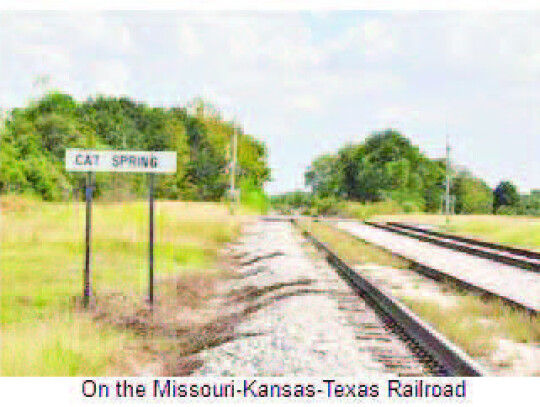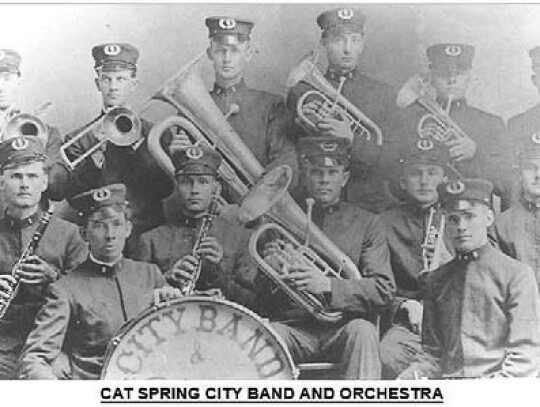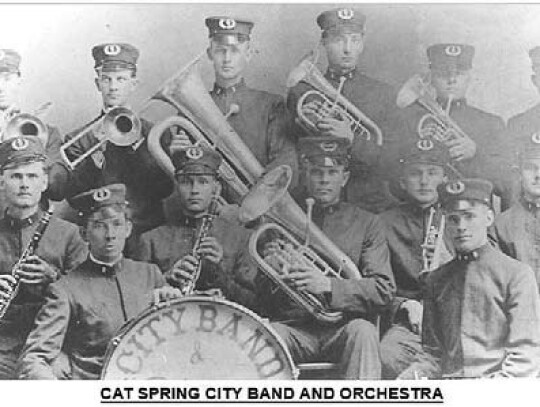Eagle Lake Remembers
Just listen to those Polkas! Who doesn’t love an old Texas Dance Hall? Just on the edge of Colorado County near Columbus and Eagle Lake is one of Texas’ best! Barbecue and a family polka dance on a Saturday or Sunday afternoon? It just doesn’t get any better than that. The polka music may turn to the famous Texas Swing. Cat Spring has it all.
To be under the great liveoak trees with the buzz of friends is bested only by the familiar thick smoke carrying the aroma of the best of Texas brisket anywhere over the low heat of native mesquite wood.
All over Texas and in Colorado County there are historic dance halls with their accompanying barbecues and festivities; but the history of the Cat Spring Hall is among the most colorful and important. Its twelve sides make it stand out from the rest. It’s hard to imagine a “round” building with twelve sides, but when you look closely, that’s exactly what you see.
Just twenty miles from Eagle Lake, at the intersection of Farm Roads 2187 and 949 lies Cat Spring, near the west bank of the Bernard Creek. Cat Spring, or “Katzenquelle,” was shortened from “Wildcat Spring,” as it was first called. It was so named when a son of the von Roeders, one of the first families, killed a puma at a nearby spring. It was a large, tawny-brown wildcat, which preyed upon smaller animals.
Today, Cat Spring is located along its first railroad, the Missouri, Kansas and Texas Railroad, established in the late 1800s. Its small “Cat Spring” railroad sign is along the tracks. While there is less activity now, there are still echoes of wagon wheels, horses, mules, and early farm tools plowing the fields. Neighbors helped neighbors in the building of the first primitive log houses. They were different from their former more comfortable homes in Europe.
While the immigrants received good reports of opportunity in Texas, their arrivals told another story. They had been enticed by descriptive letters of opportunity from an earlier German settler, Friedrich Ernst, who came to the nearby Mill Creek, in 1831.
These new immigrants led by Ludwig von Roeder, M. Amsler, and Robert Justus Kleberg came in 1834. Kleberg was educated in the law and in classical studies. His grandson, Robert Justus Kleberg II, later married Alice Gertrudis King, the daughter of Captain Richard King, and became head of the renowned King Ranch.
Kleberg, like so many immigrants, “expected that he would find in Texas more than in most countries, freedom and the blessed land of his most fervent hopes.” Those opportunities, however, came only with hard work and travail.
The Czech immigrants followed the trail to Cat Spring in the 1850s. In 1856, Protestant minister Arnost Bergman called the first meeting of the Agricultural Society of Austin County. It later became the Cat Spring Agricultural Society. It was Texas’ first Agricultural Society established to assist immigrants in the learning of agriculture and the techniques of farming for livelihood.
Cat Spring, in Austin County, was only miles from San Felipe de Austin, named for Stephen F. Austin. It was a well-located spot for agriculture, with rich, fertile soil, and a large spring at the original settlement location.
Few immigrants knew how to farm. Most were well-educated and accustomed to domestic servants at home. They sought freedom from the oppression of Prussia. Few were prepared for the hardships and ingenuity which were required for survival in their new homeland. To survive from the land required a new kind of education. They had to learn how to farm.
The agricultural society offered support. It helped the new farmers to survive through meetings, books, and oral teachings. For over 100 years the organization held weekly meetings, except during the Civil War. Exhibitions of local crops and livestock were held at the building. Some believe that these exhibits were the forerunners of the early Texas county fairs.
Today the remaining old hall designed by Joachim Hintz is a lasting reminder of the importance of this historic country hall which was, and still is used for multiple purposes. Meetings, family reunions, dances, concerts, barbecues, weddings, and local celebrations are held. The old hall still lives and is active. Many from Colorado County have made the short drive to Cat Springs, with generations now having danced to the polka tunes. There were events for the whole family.
While there is not much left of the little town itself, save a post office, an old brick building, and a couple of stores, there are many memories of an important early Texas town. It attracted well-educated German families, and later Czechoslovakians, who came eagerly to build their futures.
Be a part of the historic Cat Spring activity. Join in the old-time fun at Texas’ first Agricultural Society’s twelve-sided hall. Put on your boots and dancing shoes for a unique Cat Spring country dance with all the trimmings. Bring the family. Be a part of history.
.jpg)





